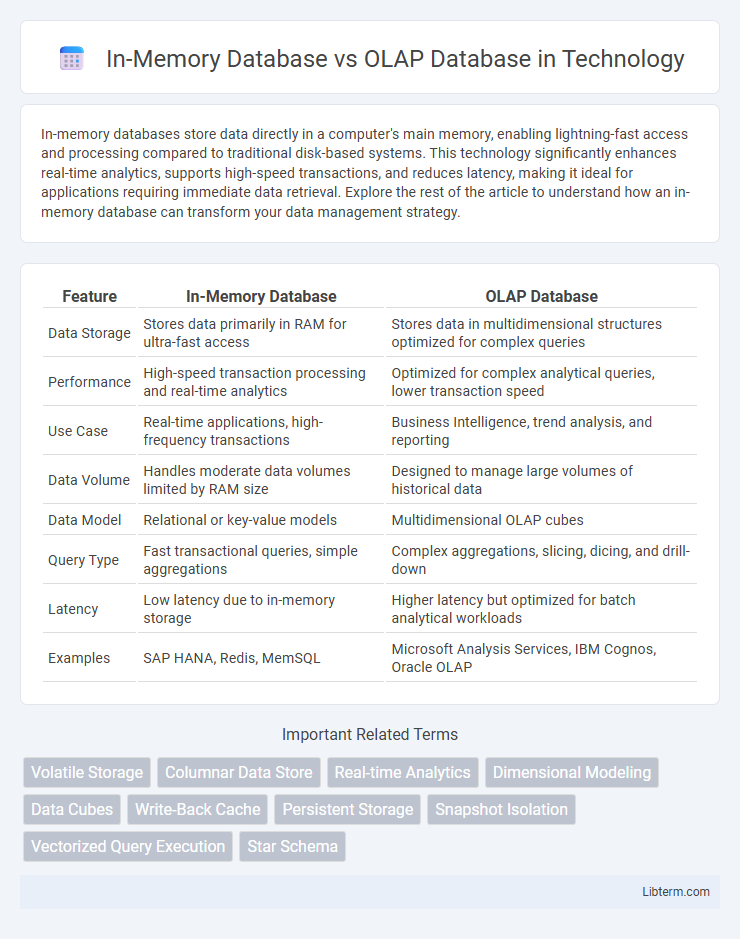In-memory databases store data directly in a computer's main memory, enabling lightning-fast access and processing compared to traditional disk-based systems. This technology significantly enhances real-time analytics, supports high-speed transactions, and reduces latency, making it ideal for applications requiring immediate data retrieval. Explore the rest of the article to understand how an in-memory database can transform your data management strategy.
Table of Comparison
| Feature | In-Memory Database | OLAP Database |
|---|---|---|
| Data Storage | Stores data primarily in RAM for ultra-fast access | Stores data in multidimensional structures optimized for complex queries |
| Performance | High-speed transaction processing and real-time analytics | Optimized for complex analytical queries, lower transaction speed |
| Use Case | Real-time applications, high-frequency transactions | Business Intelligence, trend analysis, and reporting |
| Data Volume | Handles moderate data volumes limited by RAM size | Designed to manage large volumes of historical data |
| Data Model | Relational or key-value models | Multidimensional OLAP cubes |
| Query Type | Fast transactional queries, simple aggregations | Complex aggregations, slicing, dicing, and drill-down |
| Latency | Low latency due to in-memory storage | Higher latency but optimized for batch analytical workloads |
| Examples | SAP HANA, Redis, MemSQL | Microsoft Analysis Services, IBM Cognos, Oracle OLAP |
Introduction: Understanding In-Memory and OLAP Databases
In-memory databases store data directly in RAM, enabling rapid data retrieval and real-time analytics by minimizing disk I/O latency. OLAP databases, designed for complex multidimensional queries, aggregate and analyze large volumes of historical data to support decision-making processes. Both databases optimize performance differently: in-memory focuses on speed through volatile memory storage, while OLAP emphasizes structured analytical processing for business intelligence.
Core Concepts of In-Memory Databases
In-memory databases store data directly in the main memory (RAM) to enable ultra-fast data access and processing, eliminating the latency associated with disk-based storage. Core concepts include data persistence through snapshots or transaction logs, optimized data structures like columnar storage for analytical workloads, and real-time query performance that supports dynamic and complex queries. These features contrast with traditional OLAP databases, which rely heavily on disk storage and pre-aggregated data cubes for multidimensional analysis.
Key Features of OLAP Databases
OLAP databases are designed for multidimensional analysis and complex queries, enabling fast aggregation and slicing of large datasets to support business intelligence and decision-making processes. They optimize data storage through techniques like star and snowflake schemas, allowing efficient querying of historical and summarized data. Key features include support for complex calculations, trend analysis, and data consolidation across various dimensions such as time, geography, and product lines.
Data Processing Approaches: In-Memory vs OLAP
In-memory databases leverage RAM for rapid data storage and retrieval, enabling real-time analytics and high-speed transaction processing by minimizing disk I/O latency. OLAP databases utilize multidimensional data models and pre-aggregated cubes optimized for complex querying and historical analysis, often relying on disk-based storage for large volumes of data. The core difference lies in in-memory databases prioritizing immediate data access for dynamic operations, while OLAP databases focus on structured, aggregated data processing for strategic decision support.
Performance and Speed Comparison
In-memory databases deliver significantly faster data retrieval and query processing speeds by storing data directly in RAM, reducing latency compared to traditional OLAP databases that rely on disk-based storage. OLAP databases, while optimized for complex analytical queries and multidimensional data modeling, often face slower response times under heavy workloads due to disk I/O limitations. The performance gap widens in real-time analytics scenarios, where in-memory databases enable near-instantaneous aggregation and computation, making them ideal for time-sensitive business intelligence applications.
Scalability and Flexibility Differences
In-memory databases offer superior scalability by leveraging RAM for faster data processing, enabling real-time analytics that accommodate dynamic workloads and frequent schema changes. OLAP databases prioritize complex query performance over large multidimensional datasets, often scaling vertically with less flexibility to adapt to evolving data models. The flexibility of in-memory databases supports agile data structures and rapid iteration, whereas OLAP systems rely on predefined schemas optimized for historical and aggregated data analysis.
Use Cases for In-Memory Databases
In-memory databases excel in real-time analytics, high-frequency trading, and personalized customer experiences where rapid data retrieval and processing are critical. They support applications requiring ultra-low latency and high throughput, such as fraud detection, IoT data analysis, and telecommunications network management. Unlike traditional OLAP databases optimized for complex, large-scale historical data analysis, in-memory databases prioritize speed and agility for operational intelligence and immediate decision-making.
Use Cases for OLAP Databases
OLAP databases are optimized for complex queries and multidimensional analysis, making them ideal for business intelligence, data mining, and reporting tasks. These databases support large-scale aggregation, trend analysis, and ad hoc querying of historical data to inform strategic decision-making. Industries such as retail, finance, and healthcare rely heavily on OLAP for real-time insight into sales performance, risk assessment, and patient outcomes.
Cost Implications and Resource Requirements
In-memory databases require high upfront investment in RAM and specialized hardware to ensure rapid data access and processing speeds, significantly increasing initial costs compared to OLAP databases that often utilize disk storage, offering a more economical option for large-scale analytics. OLAP databases demand extensive disk storage and CPU resources to handle complex queries across multidimensional data, leading to increased ongoing maintenance and scaling expenses. Organizations must consider that in-memory databases provide faster performance with higher operational costs, while OLAP databases balance lower costs with potentially slower query response times and greater infrastructure needs.
Choosing the Right Solution: In-Memory vs OLAP
In-memory databases provide ultra-fast data access by storing information directly in RAM, making them ideal for real-time analytics and rapid transaction processing. OLAP databases, designed for complex queries and multidimensional analysis, excel in aggregating and summarizing large volumes of historical data for business intelligence. Choosing between in-memory and OLAP depends on the specific use case: prioritize in-memory for speed and immediate insights, whereas OLAP is suited for deep, structured analysis of extensive datasets.
In-Memory Database Infographic

 libterm.com
libterm.com